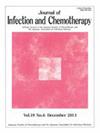abataccept治疗类风湿关节炎的老年患者弥散性猫抓病:一个病例报告和文献回顾
IF 1.5
4区 医学
Q3 INFECTIOUS DISEASES
引用次数: 0
摘要
猫抓伤病(CSD)是一种人畜共患感染,主要由猫抓伤后的亨塞巴尔通体引起。典型表现为局部皮肤症状和自限性淋巴结病;然而,在某些情况下,它可以发展为播散性病变,导致严重的并发症。我们报告一例多器官受累的CSD在一个79岁的妇女接受abataccept治疗类风湿关节炎。她表现为持续发热和疼痛的右腋窝淋巴结病,并伴有由猫抓引起的右手硬结。影像学检查显示多发肿大淋巴结及肝、脾、颈椎病变。最初,患者临床诊断为CSD,并开始阿奇霉素单药治疗;然而,她的症状持续存在。进行右腋窝淋巴结活检以重新评估诊断。组织病理学分析显示大量坏死性肉芽肿伴多核巨细胞,聚合酶链反应证实淋巴结中存在鸡selae,确定CSD多器官累及的诊断。治疗调整为阿奇霉素和利福平联合使用,导致症状逐渐改善。CSD可能表现为不明原因的发热,结外受累器官,如肝、脾、骨和中枢神经系统,或引起感染性心内膜炎,使诊断复杂化。在接受生物制剂治疗风湿病的免疫抑制患者中,综合评价是至关重要的。这应包括详细的病史、体格检查以及全面的组织学和微生物学评估,以将CSD与结核病和恶性淋巴瘤等疾病区分开来。本文章由计算机程序翻译,如有差异,请以英文原文为准。
Disseminated cat-scratch disease during abatacept therapy for rheumatoid arthritis in an older patient: A case report and review of the literature
Cat-scratch disease (CSD) is a zoonotic infection primarily caused by Bartonella henselae following cat scratches. It typically presents with localized skin symptoms and self-limiting lymphadenopathy; however, in some cases, it can progress to disseminated lesions, leading to severe complications. We report a case of CSD with multiorgan involvement in a 79-year-old woman undergoing abatacept treatment for rheumatoid arthritis. She presented with persistent fever and painful right axillary lymphadenopathy, accompanied by induration on the right hand caused by a cat scratch. Imaging studies revealed multiple enlarged lymph nodes as well as hepatosplenic and cervical spine lesions. Initially, the patient was clinically diagnosed with CSD and initiated on azithromycin monotherapy; however, her symptoms persisted. A right axillary lymph node biopsy was performed to re-evaluate the diagnosis. Histopathological analysis showed numerous necrotizing granulomas with multinucleated giant cells, and a polymerase chain reaction assay confirmed the presence of B. henselae in the lymph node, establishing the diagnosis of CSD with multiorgan involvement. Treatment was adjusted to an azithromycin and rifampicin combination, resulting in a gradual improvement in symptoms. CSD may present as a fever of unknown origin with extranodal involvement affecting organs, such as the liver, spleen, bones, and central nervous system, or causing infective endocarditis, complicating the diagnosis. In immunosuppressed patients receiving biological agents for rheumatic diseases, a comprehensive evaluation is crucial. This should include a detailed medical history, physical examination, and comprehensive histological and microbiological assessments to differentiate CSD from conditions such as tuberculosis and malignant lymphoma.
求助全文
通过发布文献求助,成功后即可免费获取论文全文。
去求助
来源期刊

Journal of Infection and Chemotherapy
INFECTIOUS DISEASES-PHARMACOLOGY & PHARMACY
CiteScore
4.10
自引率
4.50%
发文量
303
审稿时长
47 days
期刊介绍:
The Journal of Infection and Chemotherapy (JIC) — official journal of the Japanese Society of Chemotherapy and The Japanese Association for Infectious Diseases — welcomes original papers, laboratory or clinical, as well as case reports, notes, committee reports, surveillance and guidelines from all parts of the world on all aspects of chemotherapy, covering the pathogenesis, diagnosis, treatment, and control of infection, including treatment with anticancer drugs. Experimental studies on animal models and pharmacokinetics, and reports on epidemiology and clinical trials are particularly welcome.
 求助内容:
求助内容: 应助结果提醒方式:
应助结果提醒方式:


